In the 1950s and 60s Australia had a policy of supporting manufacturing development in Australia, and its capacity to absorb large numbers migrants largely reflected its industry protection. Given the operation of the then Industrial Relations Commission, those industries tended to have remuneration outcomes which enabled both the migrants coming to Australia, and the pre existing Australians, meaningful wage outcomes – generally families could live off one income. There were also exceptionally large infrastructure projects which contributed significantly to the national employment basis over a long period of time (Snowy mountains, outer suburban infrastructure in the State capitals, expansions of transport and road networks etc). Immigration and the Australian economy had a 35-40 year sweet spot as a result, making Australia one of the worlds multicultural and immigration success stories.
Australia of that era had a significantly higher domestic birth rate. A significant factor in this was that Australian (working class in particular) families could actually afford to have more children, and were more confident of their ability to remain in employment with incomes keeping pace with costs of living. House prices of that era were vastly lower (in relative terms) than now, and rental costs were also considerably cheaper. Suffice it to say that the experience of large scale immigration (both from the migrant’s side and from the pre existing Australians side) was far, far different then.
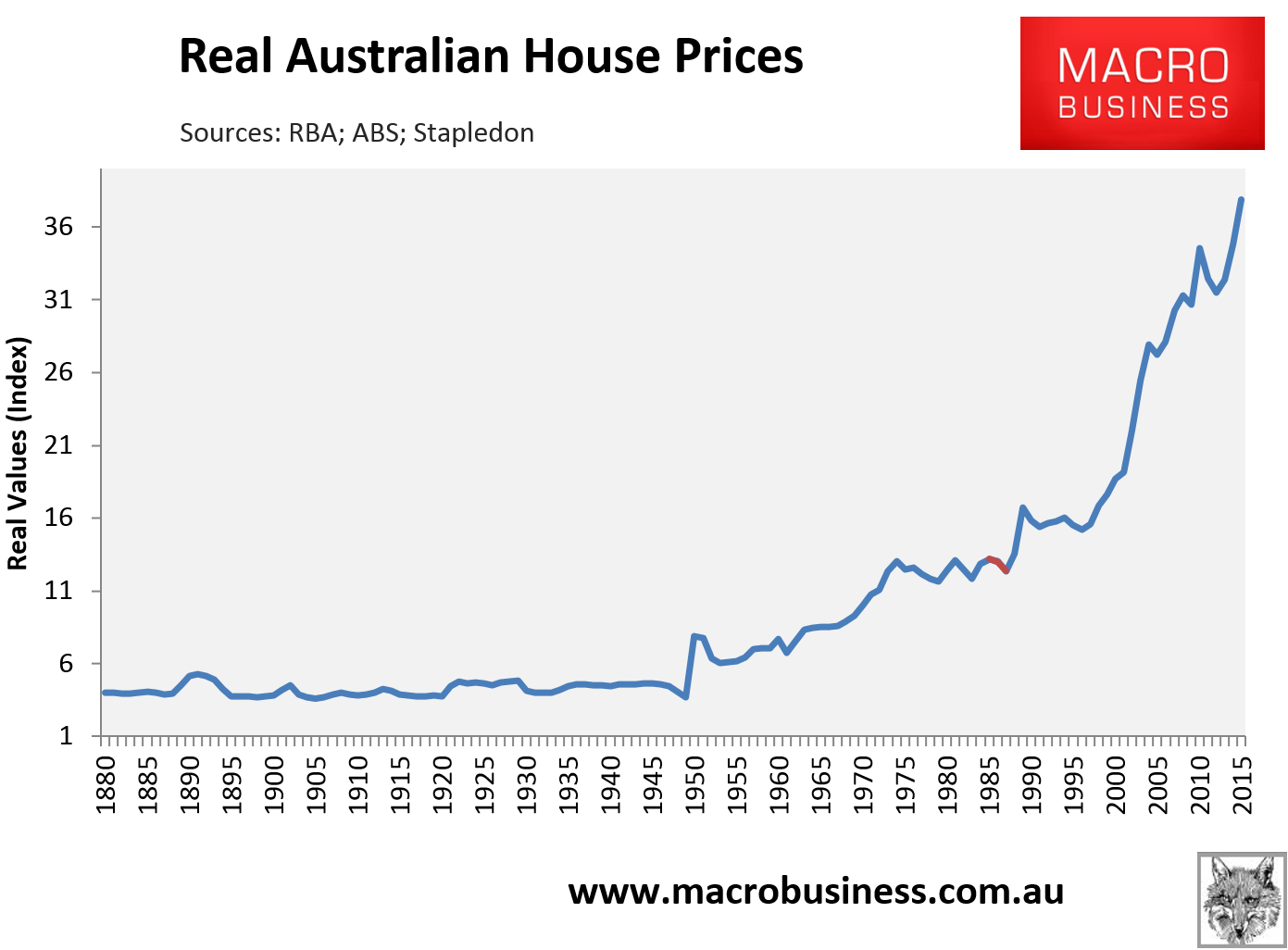
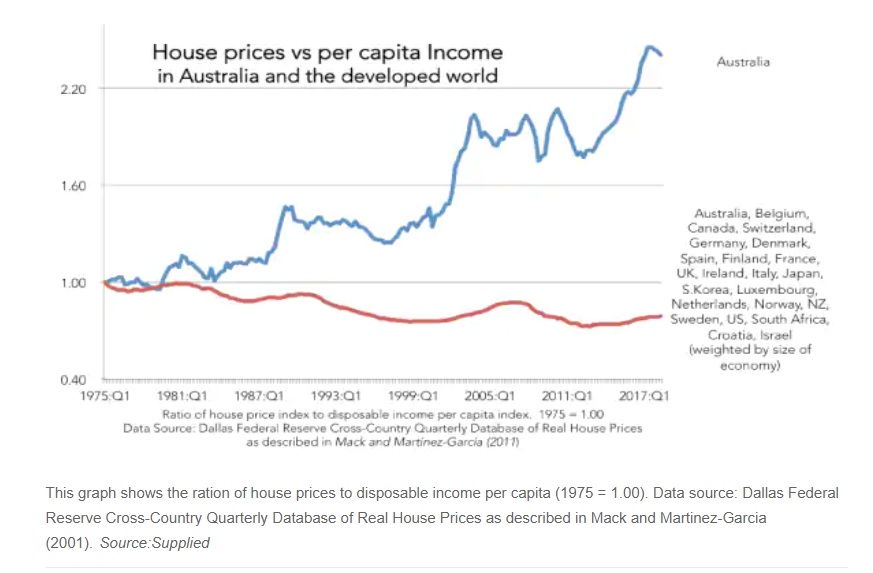
2 charts on the dynamics of Australian housing prices over the course of more than a generation. The only way has been up.
Any look at ‘living standards’ now (both that being experienced by pre existing Australians, many of whom are descendants of recent migrants, and the migrants coming to become Australians) would identify that employment is not as secure, that housing costs are considerably greater (see housing stress data), that employment related travel times are significantly greater and slower, and, of course, wage growth has seemingly ended (a decades worth of RBA forecasts of significant income growth 18 months out notwithstanding).
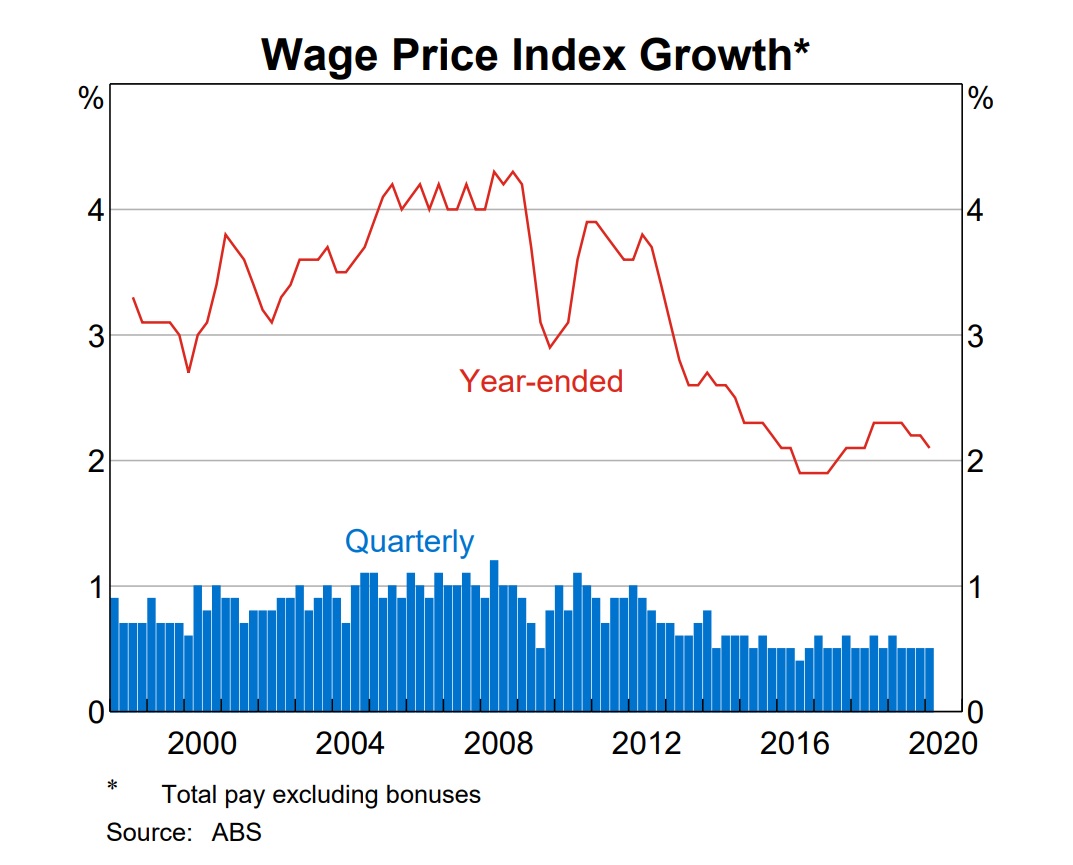
Australian wages have been nailed to the floor for some time
Immigration volumes in Australia have been driven significantly higher since 2005 by government policy. Initially this was seen as a mechanism to head off the risk of a wages outbreak upon the onset of the (China related) investment phase of the mining boom. In the 30 odd years leading to 2005 Australia averaged an average Net Overseas Migration volume of about 80-90k per annum. The last ten years have been more than double that (and nearly triple) despite it being fairly obvious since circa 2011 that the resources boom (like all resources booms) was finite and was essentially over.
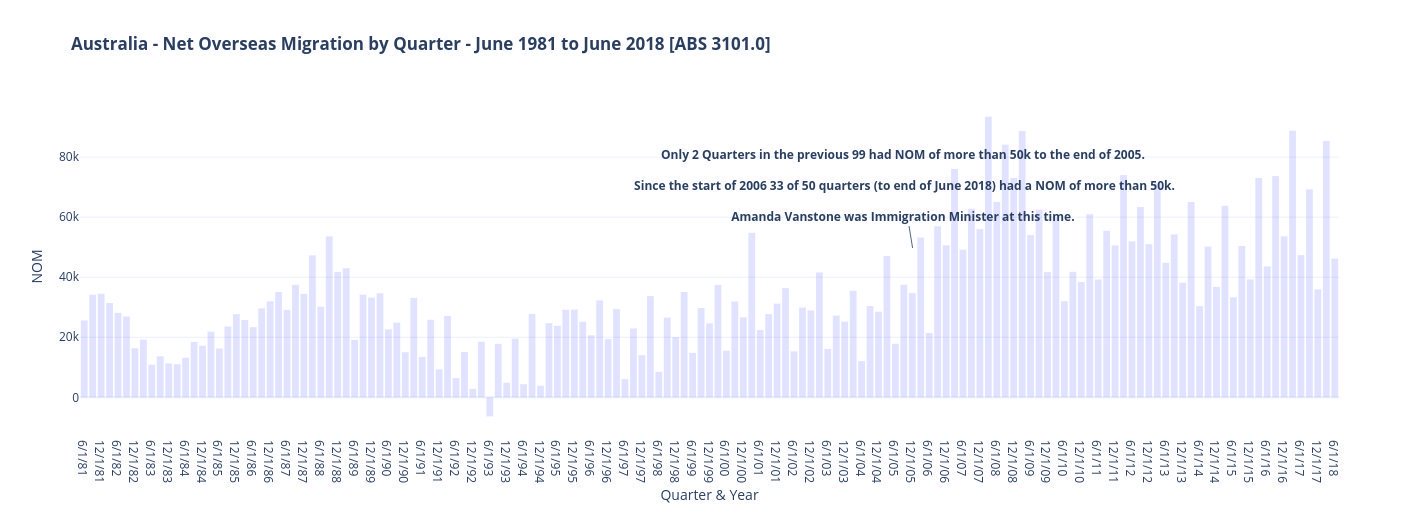
Australian Net Overseas Migration since the early 1980s. The sluices were opened in late 2005, and have remained open ever since.
In this context questions about immigration volumes by an increasing number of Australians (if not their political parties) make considerable sense. The lived experience of large numbers of Australians over the period since 2005 will drive such questions. The complete inability of politicians (particularly Liberal and Labor, who have either been in government or aspiring to be in government) to even mention immigration largely reflects the immigration volumes now being used as a sort of economic policy spakfilla to mortar in between 2 conceptual points.
The first is that outside mining Australia has about the worst economically competitive position of the developed world. Australian employees are about the most expensive on the planet. Australian land costs (underpinning not just real estate but commercial land use) are likewise. A generations worth of utterly palsied energy policy has Australia with some of the world’s most expensive energy. That means that any demand for the skills migrants may have is essentially only about providing skills to face the domestic economy.
Absolutely none of this is the fault of immigrants to Australia. But the question for a large number of Australians then becomes one of ‘If we are to continue with an expensive inward facing economy revolving around government redistributions of resources revenues and housing speculation, with the most expensive economic inputs – incomes, land and energy for starters – then why arent we simply (expensively) educating our own to provide the skills we ‘need’ and why are we importing people in such volumes in a nation which economically speaking is only on about selling off its natural bequest?’ (and looking to divide that between ever increasing numbers of people).
Part of the answer to that reflects the second conceptual point being spakfilled into place with immigration insofar as governments (both Liberal and Labor) need to continue to deliver ‘growth’. The radically increased immigration volume numbers since 2005 has been a sure fire way to continue to deliver both aggregate demand growth – the all important GDP growth (as opposed to GDP per capita growth) – and corporate growth (recognising that corporate Australia revolves largely around retailing, banking, telcos, the media etc who will harvest the increased numbers of people they are serving and post profits year in year out, except for the media) in the absence of other (economic adjustment pain free) options which might involve pain for vested interests (particularly the inward facing Australian corporate interests, but also the higher and vocational education interests – now totally addicted serving up some of the worlds most expensive courses to putative immigrants because these want to migrate to Australia [effectively doing nothing more than ‘clipping the ticket’ of immigration demand and transforming these to ‘education’ revenues to the laughable extent that some commentators refer to ‘education exports’ while ignoring the costs imposed on domestic students]).
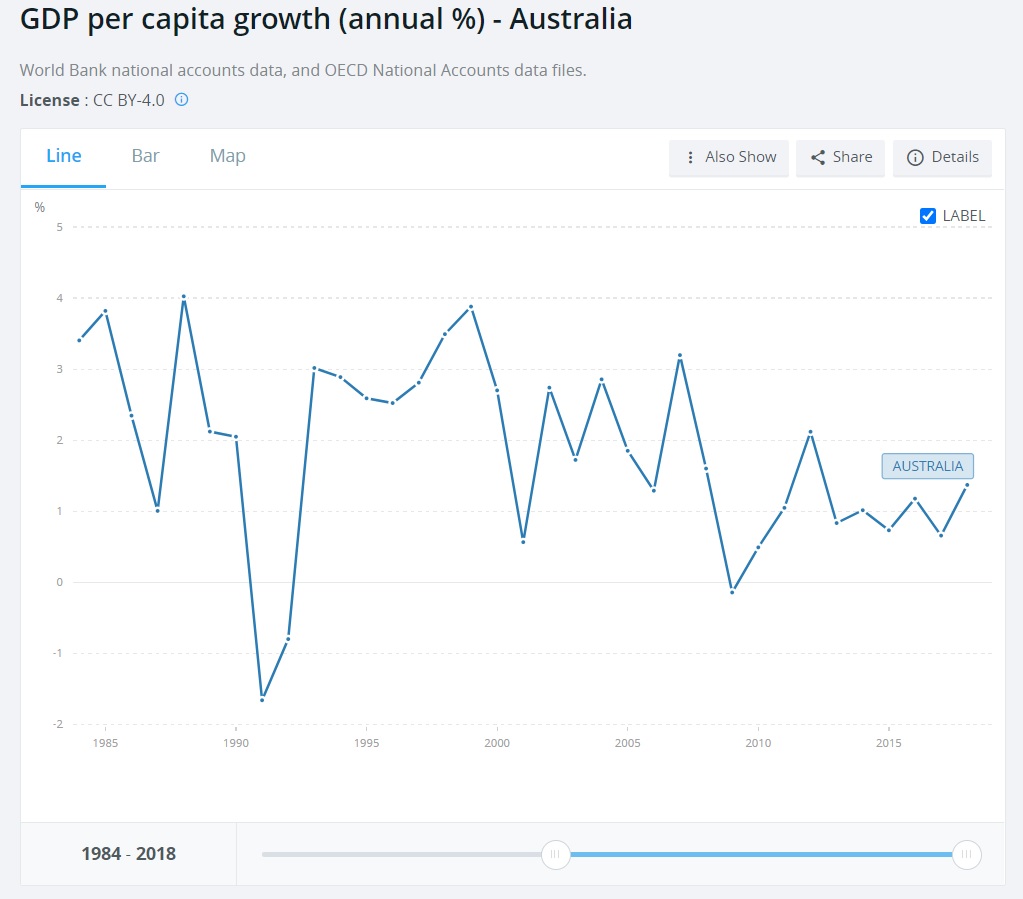
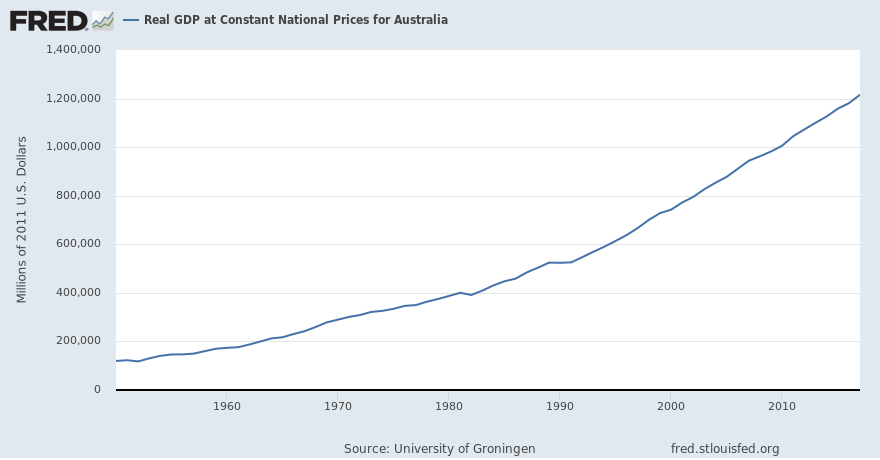
Your lived experience is above, but we keep voting for governments based on the chart below going up. The only way to make the chart below keep going up while we are experiencing the chart above trending down is to make sure there is more of us – a lot more.
Once again none of this is the fault of the immigrants, but it does reflect the Australian political & policy prioritisation of those vested interests in the short term (the next GDP numbers, the next quarterly corporate posting, or the next remuneration negotiation for Vice Chancellors) over the lived experience (the flatlining wages, rising accommodation and education costs and the ever more congested infrastructure) of the vast majority of Australians. For a long time the ‘shoosh’ response to such an observation was to point out how many Australians might lose their jobs if immigration volumes were pared in any way, and/or to highlight the implications of Australia ‘ending’ immigration [as though this were remotely being sought by anyone, or was feasible]. Now that the immigration volume has been vaporised by the COV19 response, with the economic pain which was portended by any curtailment of immigration now being experienced, there will no doubt be questions of why would we go back to heavy immigration volumes? Or there should be. It currently appears that the return to heavy immigration volumes is not just being exhorted by a range of interests, but is being portended by Government.
The backdrop to this is ideology and/or political exigency. The high point of NeoLiberalism – let’s say from the fall of the Soviet Union through to however long it can remain credible about now has seen Australia ride a debt boom (see the explosion of private debt), a China inspired resources boom, and a ‘population Ponzi ‘ (the post 2005 near trebling of Australia’s Net Overseas Migration numbers) yet for the last 10-15 years the lived experience of Australians has stagnated.
That era has seen remarkable unanimity between the Liberal and Labor sides of politics about (inter alia) euthanizing manufacturing and signing free trade agreements (often unseen) explicitly punishing import competing or exporting economic sectors outside resources agriculture and tourism for greater access to foreign markets for resources and agriculture and more tourists here. Australians know that mining employs circa 1.5% of them, and agriculture less, and that both can experience major downturns in prices and demand (and in the case of agriculture capacity to supply due to drought/flood etc). Australians also know that the vast majority of employment opportunities in tourism are low skill and low remuneration. The vast bulk of the much touted ‘services’ growth is inward facing.
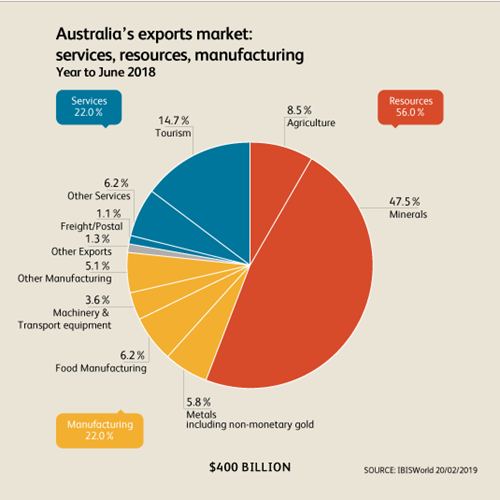
Australian exports. If you add food processing and metals processing to tourism, agriculture and minerals that leaves most of the rest of us trying to squeeze into the inward facing part of the Australian economy.
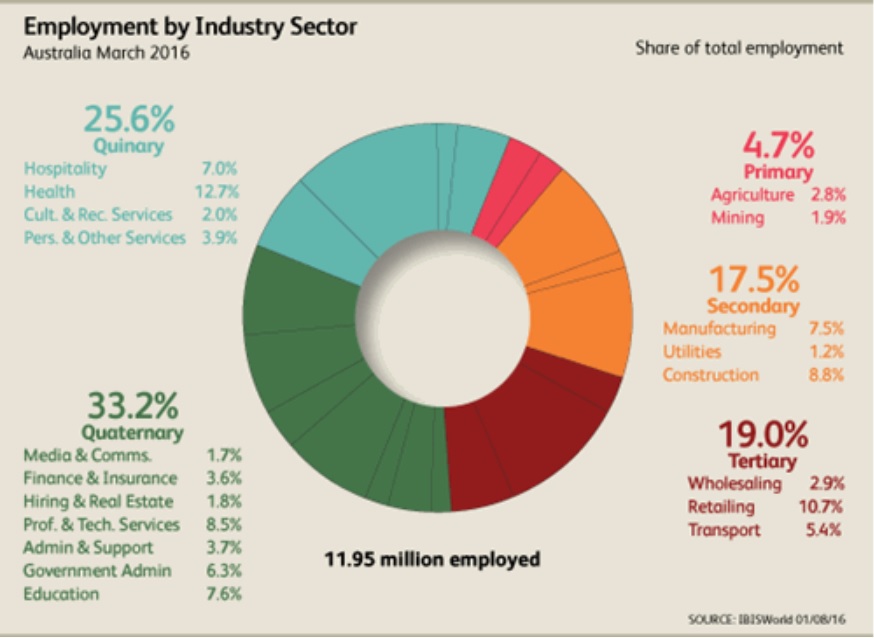
If our jobs aren’t scarlet or at least orange, then it is highly likely we are part of the bubble an awful lot of us know we are living in.
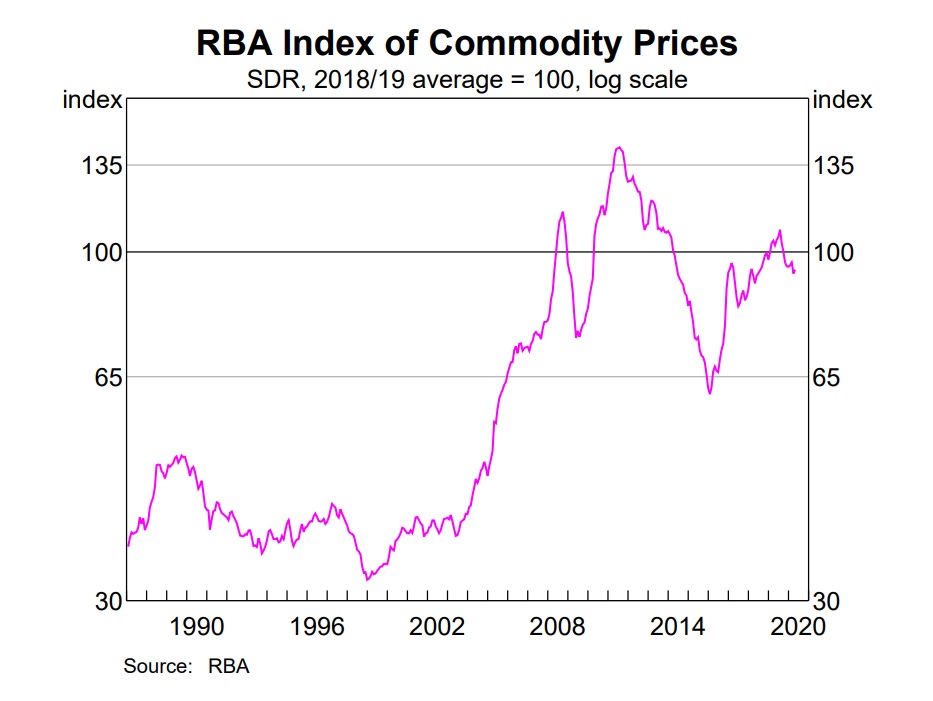
And if that commodities sector, which has been elevated for circa 15 years, should ever return to what it averaged between 1985 and 2000, then we are in for some pain.
Do we want to create a better economy for future Australians?
If this is the environment in which they are to raise children and bequest to them as their economic inheritance then it gives rise to the possibility that their politicians have coughed them up, with the population Ponzi being the only remotely plausible way of being able to point to any upside – though reading headlines about holding the record for unbroken economic expansion may not cut much mustard for double income families in debt stress. The credibility chasm which has opened between Australians and their politicians over the years since the early 2000s suggests it may not be plausible for that much longer, regardless of the management of the COV19 economic recovery.
Similarly, in encouraging immigration in the volumes Australia has done for the last 15 years, in the context in which it does – sans a meaningful economy – Australia is squibbing on the expectations of many immigrants. Do they want their children ransomed in an uncompetitive economy with high housing costs, low incomes growth, and crowded infrastructure? Do they want their children to find careers in Australia? How many of them really want to buy some of the world’s most expensive houses and pay them off with feeble incomes growth? Looking at these questions brings to light other potentially significant differences between Australia’s past immigrants and those of today.
Who wants to be a future Australian?
40, 50 & 60 years ago their Greek, Italian and Vietnamese (Turkish English Irish, German etc) predecessors tended to be refugees of economic or political misfortune (eg the WW2 destruction in Europe, the collapse of South Vietnam, political upheavals in Greece, Turkey or Cyprus) and once they came to Australia they had to make the best of it. For good or bad they were in it in the same way as the locals, and had to make their choice work, and generally they had to make it work through the fruits of their labours here in Australia. Unquestionably they did, and they helped create a way of life which had (and still has) considerable allure, and has made Australian cities (in particular) amongst the world’s safest and most multicultural.
Fast forward to 2020 and many of the recent immigrants are different. They are arriving from the now rapidly developing economies of Asia – particularly China and India. They are no longer the scrappers but often the more affluent of those societies, and their sources of affluence often remain in those nations. Indeed questions remain over how many may potentially be beneficiaries of corruption in their homelands, given the lack of data about how vigorously this is looked at by either immigration authorities, Austrac, or the Foreign Investment Review Board. But beyond even that there is a further question arising largely due to their relative affluence – how many are here because they want to be in Australia, and want their children to be Australians, as opposed to how many want capacity to be here in case something happens in their homeland, be it political or legal? Are they coming to Australia to become one of ‘us’ or are they coming to Australia to become a better sheltered one of ‘them’?
Is Australia using immigration to benefit Australia?
They dominate (particularly the Chinese) the ranks of the Special Investor Visas governments around Australia use to cultivate greater investment in Australia, when all this seemingly spurs is ‘investment’ in financial paper or real estate, and it’s linkage to employment outcomes or general economic benefit to Australia is pretty marginal. This too is nothing to blame immigrants for. We have made the opportunities available and they have taken them up. If we don’t regulate the opportunities we make available through our policies to foreign nationals it is not their fault – it is Australia’s and particularly Australia’s political and media (and the corporate pressures impacting on that media) elites. And what we manifestly aren’t doing is making the additional people fit into a national narrative about where the country is going economically.
Accountability 101 – the answer starts with ‘Us’ ‘We’ & ‘Our’
Ultimately it is ‘Our’ fault. Australians have watched on as Australian Universities became so wedded to foreign students that of course they bend to the political imperatives of the home of those students. At the same time we have watched on as property developers almost solely focussed on creating dog box apartments in our inner urban areas exhort more, more, more when it comes to foreign demand for Australian real estate. We have watched on as foreign nationals buy Australian real estate through the flimsiest of regulatory processes and our regulators and politicians have looked the other way. We have watched on as the heaviest immigration we have ever known was shunted not into something productive, not into something requiring the deployment of skills, not into something adding the the economic substance of the country, but to pull up an abode and join the consumption rush.
Even more pathetically, we have watched on as one of the major sources of that immigration became ever more aggressive in terms of pushing its line on us – be it security officials knocking on doors in pursuit of corruption beneficiaries who have migrated here, or security officials toning down protest in Australia, or ships being delayed at ports after Australian politicians or regulators did something that country wasn’t happy with, or openly bribing Australian politicians, corporate or educational identities to get them to exhort that nation’s line to us in Australia – as Australia’s economic dependence on China, deliberately crafted by our elites over a generation, amplified that risk. How monumentally stupid are we? I say that as someone who actually believes that if we do have a legitimate need for migrants, then the vast bulk of Chinese migrants are pretty much what we want – they tend to be hard working, respect science and educational attainment and encourage that in their children, they are generally very law abiding, and they tend to want a quiet peaceful life for themselves and their children. A significant number of them, particularly the migrants from the Tienanmen Square era are also often exceptionally hostile to the Communist regime in China. It is we who have managed our immigration in such a way as to allow this potential source of highly motivated contributors to Australia’s economic future to become such a major economic risk.
It is us who have stuffed Australian immigration policy, by stuffing us with more migrants than our economy can usefully handle, and it is our politicians and ‘elites’ ignoring our concerns and feeding us half baked lies about the costs, benefits, volumes of, and reasons for ‘our’ immigration, as well as where it fits in an economic narrative sense. It is we who have bamboozled ourselves behind the faux ‘racism’ of even questioning immigration volumes. It is us who have been sold time and time again fibs of the ‘we need migrants to pay our pensions’ or ‘we need skills we don’t have in Australia’ kind. It is us who have listened to ‘there will be a major economic shock if we don’t continue running heavy immigration’ and assumed we just keep running it – sort of like a drug addict knowing the substance they abuse is bad for them but wanting the extra hit anyway.
Where to from here?
So here we are in 2020. The immigration has crashed, the economy is going backwards. Already we have our ‘elites’ flagging a need to get that immigration back to somewhere near what it was just six months ago, despite widespread doubt we are in for anything other than a protracted economic downturn. But still nobody seems to want to step forward to say how we are going to use the immigration, what it is that the migrants will bring with them that we as a nation will economically benefit from, and how we will use that immigration to create a better economic bequest for future Australians – including the migrants coming here and their children, who for the most part will be future Australians. At best we seem to get the half baked assumptions that we can again boost aggregate demand, possibly minimise price falls for some of the most expensive real estate on the planet, or fairytales about how we will become green energy giants or become part of the global space industry. Does anyone actually believe any of this will deliver much for the person on the streets?
Part of the reticence to actually identifying, using data, what we are doing with immigration, as well as actual immigration volumes, reflects a political and policy mindset of not wanting governments to choose winners, and allowing ‘the market’ to sort things out. That may seem, and may well be, a great policy position, but the simple fact of the matter is our policymakers have been choosing winners and losers all the way along. The demise of carmaking and manufacturing was government policy. The eye glazing expense of housing is government policy. The world’s most expensive university courses are government policy as is our corrupted vocational education sector. Our flatlining incomes and your debt stress are government policy, as is the casualisation of employment. Our completely insane energy costs are government policy. An Australian dollar nailed to the roof by bank borrowings from global capital markets is government policy, the same as regulatory toothlesness in the face of corporate malfeasance. A taxation setting punishing PAYE taxpayers and rewarding speculation by those with access to capital is government policy. Placing all of our economic eggs in a basket belonging to a nation fundamentally ill disposed towards liberal democratic traditions has been Australian government policy. It is time to be a little more up front about all this, and to put in place policy to make policy work for all Australians, including migrants and their children who will become Australians.
How about a bit of honesty with the Australian public?
Australians aren’t that ill disposed towards migrants, and nobody in their right mind thinks that ending immigration per se is going to be anything but a painful experience. While I don’t doubt that plenty of recent migrants here have experienced something they would associate with racism, as someone who has lived much of his adult life overseas I don’t think Australians are particularly racist and are probably less racist than many other societies – including those from where most of our migrants come from. Racism may drive questions about immigration, but the lived economic experience drives more. And it’s time for our politicians and policymakers to start addressing the lived economic experience of Australians, and tailoring Australia’s immigration volumes to that experience. Somewhere in our political system needs to identify the shortcomings of the lived experience and map out a growth strategy which alleviates those issues and incorporates immigration meaningfully. And until that political entity arises, the credibility of our politicians, policymakers and ‘elites’ will continue to erode.
Now that the economy is in free fall, we are no longer defending ‘growth’. We need to go out and create it again. And if we want heavy levels of immigration we should be pretty clearly mapping out – with hard data – what sort of immigrants we need and how they will fit into the growth narrative, as well as measuring how we are progressing against that narrative. And if we aren’t measuring up, we shouldn’t be taking the migrants in the numbers we have been. If we do, all we are doing is selling a pup to ourselves and the migrants we encourage to join us.